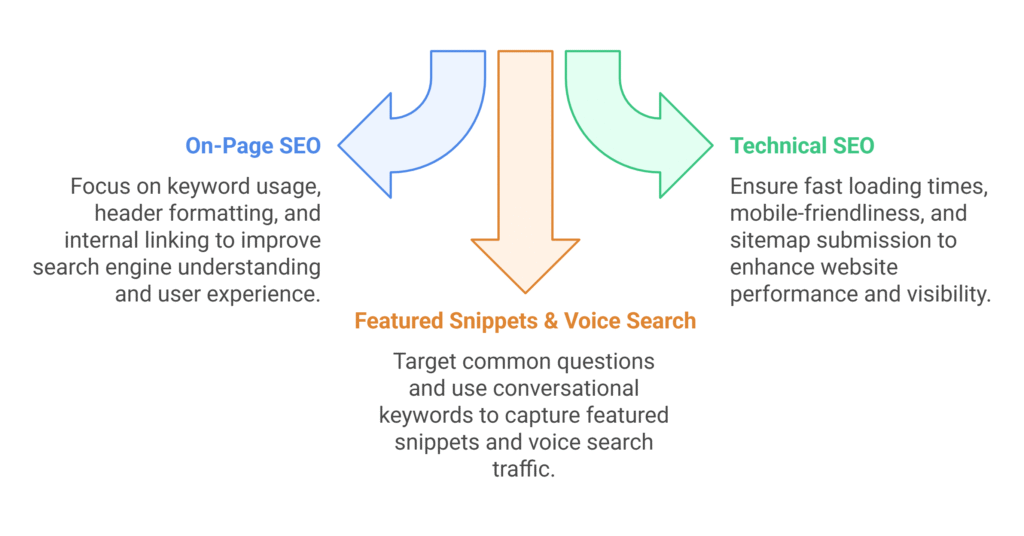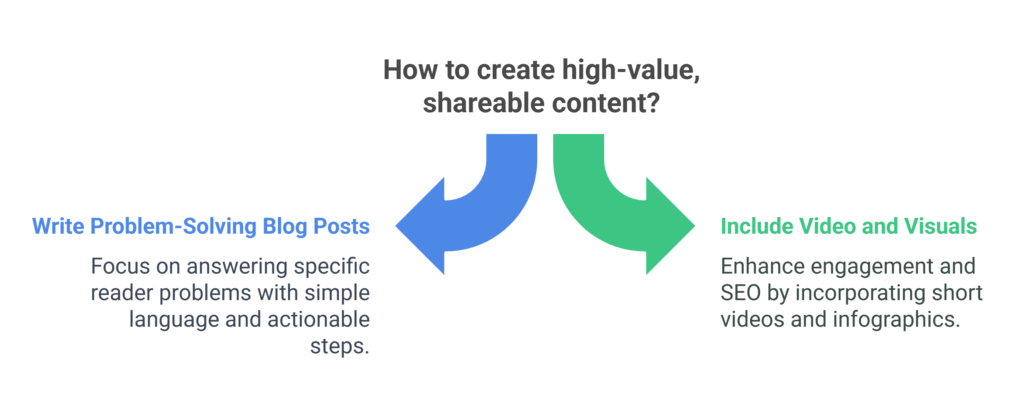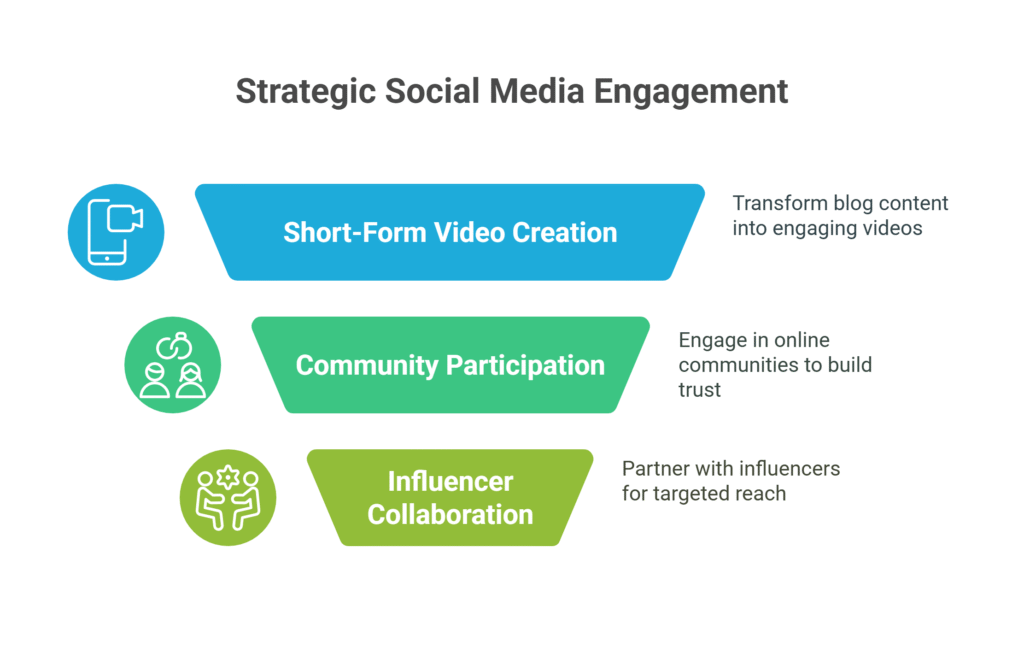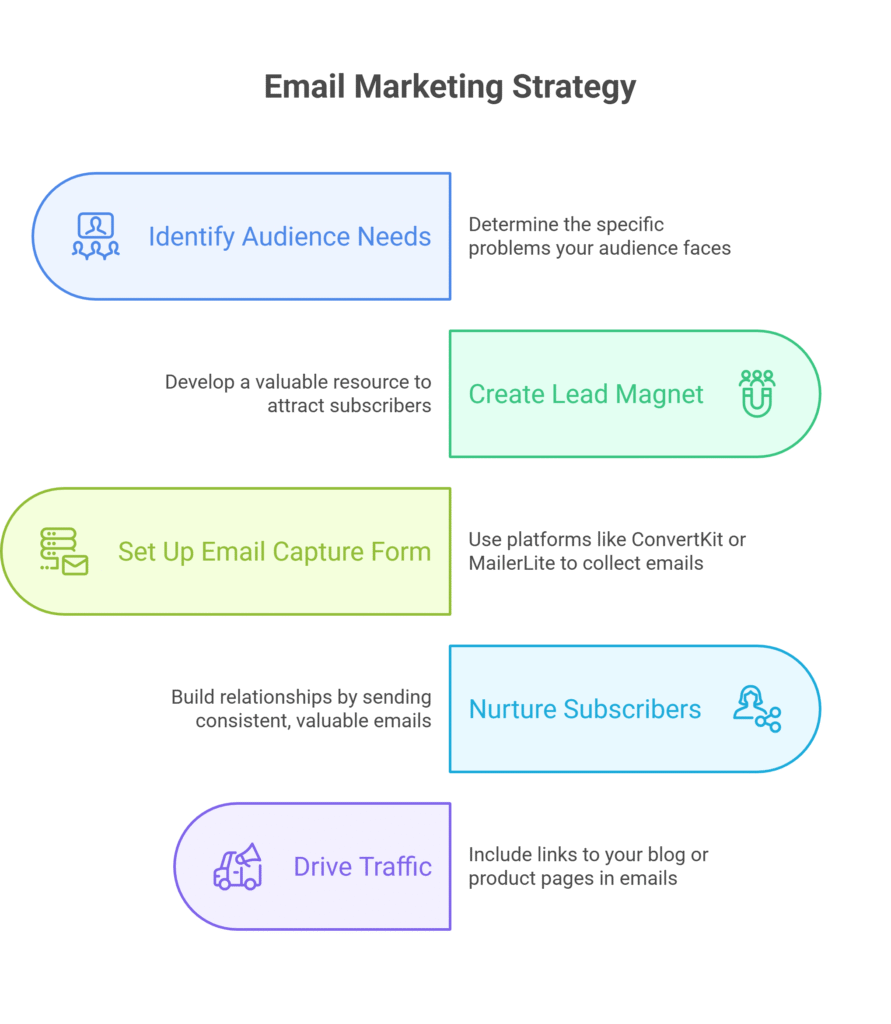Want more people visiting your website? I get it. Whether you’re just starting out or looking to boost an existing site, driving traffic can feel overwhelming. But here’s the good news: it doesn’t have to be complicated. This guide shows you everything you need to know using strategies that actually work right now in 2025.
I’ve spent years helping websites grow from zero to thousands of visitors per month. The tactics I’m sharing here aren’t theoretical; they’re the same methods I use every day to drive real, measurable traffic growth. With 68% of online experiences beginning with a search engine according to BrightEdge research, understanding how to capture this traffic is more crucial than ever.
Ways of Driving Traffic to Your Websites in 2025
We have described every effective way that you can apply to your website to bring thousands of web visitors. Let’s begin….
1. Optimize Your Website for Google

Search engine optimization remains the king of website traffic. Why? Because when someone searches for what you offer, they’re already interested. That’s the best kind of visitor you can get.
But SEO in 2025 isn’t just about stuffing keywords into your content. Google’s gotten smarter, and so should your approach. 96.55% of pages get no organic search traffic from Google, according to Ahrefs research, which makes proper optimization even more critical.
1.1. On-Page SEO
Think of on-page SEO as the foundation of your house. Get this wrong, and everything else becomes much harder.
- Use your target keyword in the title, meta description, and first 100 words: This tells Google what your page is about. But here’s the trick—make it sound natural. If you’re writing about “email marketing tips,” don’t force that exact phrase five times in your opening paragraph. Instead, weave it in naturally: “These email marketing tips have helped thousands of businesses increase their open rates.”
- Format content with header tags (H1, H2, H3): Headers are like a roadmap for both readers and search engines. Your H1 should be your main title. H2s break up major sections. H3s handle subsections. This isn’t just good for SEO—it makes your content way easier to read.
- Include relevant internal links to other blog posts: This is where many people miss out on easy wins. Every time you publish a new post, go back to 2-3 older posts and add links to your new content where it makes sense. This helps Google understand your site structure and keeps visitors reading longer.
1.2. Technical SEO
Technical SEO sounds scary, but it’s really just making sure your website works well. Think of it as basic maintenance that pays huge dividends.
- Make sure your site loads fast (Core Web Vitals optimization): Google cares about page speed because users do. If your site takes more than 3 seconds to load, you’re losing visitors before they even see your content. 53% of mobile users abandon sites that take longer than 3 seconds to load, according to Google research.
- Use a mobile-first design that works well on phones and tablets: More than half of all web traffic comes from mobile devices. Your site needs to look and work great on a phone screen. Test this by viewing your site on your phone—if you have to pinch and zoom to read anything, you’ve got work to do.
- Submit your sitemap to Google Search Console: This is like giving Google a map of your website. It helps them find and index your pages faster. If you’re using WordPress, plugins like Yoast SEO can create this automatically.
Pro tip: Set up Google Search Console if you haven’t already. It’s free and gives you insights into exactly how people find your site through Google searches.
1.3. Featured Snippets & Voice Search
Featured snippets are those boxes that appear at the top of Google search results with quick answers. Getting into these can dramatically increase your traffic.
- Answer common questions in short, clear sentences (50-60 words): When you’re writing, think about the questions your audience asks. Then answer them directly and concisely. For example: “What is email marketing? Email marketing is a digital strategy that involves sending targeted messages to a group of subscribers via email to promote products, share news, or build relationships.”
- Format answers in lists, paragraphs, or tables: Google loves well-formatted content. Use numbered lists for step-by-step processes, bullet points for features or benefits, and tables for comparisons.
- Use long-tail, conversational keywords (“how do I…”): People talk to their phones differently than they type. Optimize for phrases like “how do I increase website traffic” instead of just “website traffic.” These longer phrases are often easier to rank for and attract more qualified visitors.
2. Create High-Value, Shareable Content

Content is still king, but not just any content. In 2024, you need content that actually helps people solve real problems. Generic, surface-level posts won’t cut it anymore.
The secret is to create content so useful that people bookmark it, share it with friends, and come back to reference it later.
2.1. Write Blog Posts That Solve Problems
Every piece of content you create should answer this question: “What problem does this solve for my reader?” If you can’t answer that clearly, don’t publish it.
- Use simple language and actionable steps: Write like you’re explaining something to a friend over coffee. Avoid jargon unless you define it. Break complex processes into simple, numbered steps. For example, instead of “Implement comprehensive SEO optimization,” say “Follow these 5 steps to improve your Google rankings.”
- Add real examples, visuals, and templates: Don’t just tell people what to do—show them. Include screenshots, before-and-after examples, and downloadable templates they can use immediately. This transforms your blog from just information into a practical toolkit.
- End each post with a clear call-to-action: What do you want readers to do after reading your post? Download a resource? Read another article? Sign up for your newsletter? Make it obvious and easy.
Here’s what this looks like in practice: Instead of writing “Email Marketing Best Practices,” write “How I Increased Email Open Rates by 40% in 30 Days (With Templates).” The second version promises a specific outcome and includes practical resources.
2.2. Include Video and Visuals
Text-only content is becoming less effective. People want visual learning experiences, and search engines reward multimedia content.
- Create short explainer videos (1–3 minutes): You don’t need expensive equipment. A simple screen recording explaining a process or a quick talking-head video sharing a tip can be incredibly effective. Tools like Loom make this easy—you can record, edit, and share videos in minutes.
- Embed YouTube videos and shorts into posts: If you create videos, embed them in your blog posts. This increases time on page (good for SEO) and gives people different ways to consume your content. YouTube Shorts are particularly effective for reaching new audiences.
- Use Canva to design infographics and content previews: Visual content gets shared 40 times more than text-only content. Create simple infographics that summarize your main points, quote graphics with key takeaways, and preview images for social media sharing.
3. Use Social Media

Social media for traffic generation has changed dramatically. Simply posting links to your blog posts won’t drive meaningful traffic anymore. You need to be more strategic and provide value within the social platforms themselves.
3.1. Post Short-Form Video
Short-form video is dominating social media feeds. Platforms are prioritizing this content, which means more visibility for creators who embrace it.
- Create Reels, TikToks, and YouTube Shorts around your topic: Take your blog post topics and turn them into quick video tips. A 2,000-word article about email marketing could become 10 different short videos, each focusing on one specific tip. This multiplies your content’s reach exponentially.
- Use trending sounds, hashtags, and hooks: Each platform has its own culture. On TikTok, trending sounds can massively boost your reach. On Instagram, relevant hashtags help with discoverability. Study what’s working in your niche and adapt those strategies to your content.
Pro tip: Create a “content multiplication system.” For every blog post you write, plan 3-5 short videos that expand on different points from the post. This gives you weeks of social media content from one piece of writing.
3.2. Join and Participate in Online Communities
Community marketing is making a huge comeback. People trust recommendations from community members more than traditional advertising.
- Offer helpful advice on Reddit, Facebook Groups, and industry forums: Find where your target audience hangs out online and become genuinely helpful. Answer questions, share insights, and build relationships. The key word here is “helpful”—don’t just promote your stuff.
- Link to your content only if it directly helps: When someone asks a question that your blog post answers perfectly, share it. But make sure you’re adding value to the conversation, not just dropping links. A good rule: For every link you share, make at least 10 helpful comments without any links.
I’ve seen single Reddit comments drive thousands of visitors to websites. But it only works when you’re genuinely contributing to the community, not just promoting yourself.
3.3. Collaborate with Influencers or Micro-Creators
Influencer marketing isn’t just for big brands. Small businesses and bloggers can benefit enormously from partnerships with micro-influencers in their niche.
- Partner with credible creators for shoutouts or co-content: Look for creators who have engaged audiences in your niche, even if they only have 1,000-10,000 followers. These partnerships are often more affordable and can drive highly targeted traffic to your site.
- Use tools like Collabstr or Heepsy to find niche influencers: These platforms help you find creators based on specific criteria like audience demographics, engagement rates, and content topics. You can often arrange partnerships for free products, small payments, or revenue sharing rather than large upfront fees.
4. Grow with Email Marketing

Email marketing consistently delivers the highest ROI of any digital marketing channel. While social media algorithms change constantly, your email list is an asset you own and control.
The key is building a list of people who actually want to hear from you, then nurturing those relationships over time. Email marketing generates $36 for every $1 spent, according to Litmus research.
4.1. Offer a Lead Magnet
A lead magnet is something valuable you give away in exchange for an email address. The best lead magnets solve a specific problem quickly.
- Give away a checklist, template, or mini-course: Think about what your audience struggles with most. Can you create a checklist that simplifies a complex process? A template that saves them hours of work? A short email course that teaches a valuable skill? These practical resources perform much better than generic newsletters.
- Use ConvertKit or MailerLite to set up your email capture form: Both platforms offer free plans for smaller lists and include everything you need: form builders, automation sequences, and analytics. The setup takes about 30 minutes and can start generating leads immediately.
Examples of effective lead magnets: “The 30-Point Website Launch Checklist,” “Email Template Library: 15 High-Converting Templates,” “5-Day SEO Quick-Start Course.” Notice how specific and actionable these are.
4.2. Nurture Your List
Getting email subscribers is just the beginning. The real magic happens in building relationships with those subscribers over time.
- Send 1–2 useful emails per week with tips, tools, or new content: Consistency matters more than frequency. Whether you email once a week or twice, stick to your schedule. Each email should provide standalone value—even if someone never visits your website, they should benefit from your emails.
- Include links back to your blog or product pages: Every email is an opportunity to drive traffic. Share your latest blog posts, highlight popular older content, or direct people to relevant services. But make sure the email itself is valuable—don’t just send links without context.
Here’s a simple email formula that works: Share a quick tip or insight, tell a brief story or give an example, then link to related content for people who want to learn more. This approach provides immediate value while encouraging clicks.
5. Use Smart Paid Advertising
Paid advertising can accelerate your traffic growth, but only if you do it strategically. The key is starting small, testing what works, then scaling successful campaigns.
Many people waste money on ads because they try to do too much too fast. Instead, focus on one platform and one campaign type until you see consistent results.
5.1. Google Ads
Google Ads can drive immediate, targeted traffic to your website. The people clicking your ads are actively searching for what you offer, making them high-intent visitors.
- Bid on high-intent, niche keywords (e.g. “best CRM for freelancers”): Avoid broad, expensive keywords like “marketing” or “business software.” Instead, target specific phrases that indicate buying intent. Long-tail keywords are cheaper and often convert better because they match exactly what people are looking for.
- Use landing pages with one clear call-to-action: Don’t send ad traffic to your homepage. Create specific landing pages that match your ad copy and have one clear goal: getting visitors to download your lead magnet, sign up for a trial, or make a purchase. Remove navigation links and other distractions that might lead people away from your main goal.
5.2. Paid Social Campaigns
Social media advertising works differently than search ads. People aren’t actively looking for your solution—you’re interrupting their social media experience. This means your ads need to provide immediate value or entertainment.
- Target your audience on Facebook, Instagram, or TikTok: Each platform has sophisticated targeting options. Start with demographics and interests, then create lookalike audiences based on your existing customers or email subscribers. The key is testing different audience segments to find what works.
- Start with $5–$20/day to test headlines and formats: Before spending big money, test different ad formats: single images, carousels, videos, or stories. Test different headlines, descriptions, and calls-to-action. Most campaigns need at least a week of data before you can determine what’s working.
Pro tip: Use social media ads to promote your best content rather than directly selling products. A blog post that solves a common problem can attract engaged visitors who are more likely to join your email list or explore your services.
6. Leverage AI Tools for Faster Content
AI tools have revolutionized content creation, but they’re not magic solutions. The key is using them to enhance and speed up your process, not replace human creativity and expertise.
Think of AI as a really smart research assistant and writing collaborator, not as a replacement for your own knowledge and voice.
6.1. Use ChatGPT or Jasper to Brainstorm
The hardest part of content creation is often just getting started. AI tools excel at breaking through creative blocks and generating ideas you might not have considered.
- Generate outlines, first drafts, and headline ideas: Ask ChatGPT to create 10 different headlines for your topic, or to outline a comprehensive guide about your subject. Use these as starting points, then add your own expertise, examples, and personality. The AI gives you the framework; you provide the valuable insights.
For example, if you’re writing about social media marketing, you might prompt: “Create an outline for a comprehensive guide about Instagram marketing for small businesses in 2024.” Then use that outline as your foundation, expanding each section with your own knowledge and examples.
6.2. Optimize with SurferSEO, Frase, or Clearscope
These AI-powered SEO tools analyze top-ranking pages for your target keywords and suggest optimizations to help your content compete.
- Match content to ranking pages with AI suggestions: These tools show you what topics to cover, what questions to answer, and what related terms to include. They take the guesswork out of SEO optimization by showing you exactly what Google rewards for your target keywords.
The workflow is simple: Write your content first, then use these tools to identify gaps or optimization opportunities. They might suggest adding a section about a related topic or including specific terms that competing pages mention.
7. Track What’s Working (and What’s Not)
The difference between successful websites and struggling ones often comes down to measurement. You need to know which strategies are driving traffic and which are wasting your time.
But tracking doesn’t have to be complicated. Focus on a few key metrics that directly relate to your goals, and check them regularly to guide your decisions.
7.1. Use Google Analytics
Google Analytics is free and provides incredibly detailed insights about your website traffic. The key is knowing which metrics actually matter for your goals.
- Track traffic sources, time on page, bounce rate: Traffic sources show you which marketing channels are working best. Time on page indicates whether people find your content engaging. Bounce rate reveals whether visitors are exploring your site or leaving immediately. Together, these metrics tell you not just how much traffic you’re getting, but how engaged that traffic is.
- Identify your highest-performing content: Look at which pages get the most traffic, keep people engaged longest, and generate the most conversions. Then create more content similar to your top performers. This data-driven approach is much more effective than guessing what topics to cover next.
Set up weekly or monthly reviews of your analytics. Look for trends over time rather than daily fluctuations, and use insights to inform your content and marketing strategies.
7.2. A/B Test Pages with Google Optimize or VWO
A/B testing involves showing different versions of a page to different visitors to see which performs better. Small changes can sometimes produce significant improvements in traffic and conversions.
- Test headlines, email opt-ins, or call-to-action buttons: Start with elements that could have the biggest impact. A more compelling headline might increase click-through rates from social media. A better email opt-in offer could double your subscriber growth. Different call-to-action button text might increase conversions by 20% or more.
Begin with one test at a time, and let each test run long enough to gather meaningful data—usually at least a week or 100 visitors per variation. The insights you gain will compound over time, leading to steady improvements in your results.
8. Build Backlinks with Authority
Backlinks—links from other websites to yours—remain one of the strongest ranking factors for search engines. But link building in 2024 requires a strategic, value-first approach.
The days of buying links or using link farms are long gone. Today’s effective link building focuses on creating genuinely valuable content and building real relationships in your industry.
8.1. Guest Posting
Guest posting involves writing articles for other websites in exchange for a link back to your site. When done right, it can drive both referral traffic and SEO benefits.
- Write value-packed posts for niche blogs: Focus on websites that serve your target audience. A high-quality guest post on a smaller, niche site is often more valuable than a mediocre post on a large, general site. Research the site’s content style and audience before pitching ideas.
- Include a link back to your best resource: Don’t just link to your homepage. Link to your most comprehensive guide, useful tool, or valuable resource that directly relates to your guest post topic. This provides genuine value to readers and is more likely to drive engaged traffic.
The key to successful guest posting is leading with value. Your pitch should focus on what you can offer their audience, not what you hope to gain. Propose specific, actionable topics that their readers would find genuinely helpful.
8.2. HARO & Digital PR
Help a Reporter Out (HARO) connects journalists with expert sources. Contributing to news stories and articles can earn high-quality backlinks from authoritative publications.
- Answer journalist queries at helpareporter.com: HARO sends daily emails with requests from journalists looking for expert quotes, data, or insights. When your response gets used in an article, you typically receive a link back to your website. The key is providing genuinely helpful, quotable responses rather than promotional content.
- Pitch data-backed stories to news outlets with original research: Conduct surveys, analyze industry trends, or compile interesting data about your field. Then pitch these findings as potential story ideas to relevant publications. Original research is incredibly valuable to journalists and often results in multiple backlinks as other sites reference your data.
Success with HARO and digital PR requires consistency and patience. You might send dozens of responses before getting your first placement, but the links you earn are typically from high-authority sites that can significantly impact your search rankings.
Conclusion
Driving traffic to your website doesn’t happen overnight, but with the right mix of content, tools, and strategy, you can see meaningful growth much faster than you might expect. The key is starting with the basics—solid SEO, valuable content, and consistent promotion—then gradually testing and adding new tactics.
Focus on those strategies for the next 30 days. Track your results, learn what works for your specific audience, then gradually expand your efforts. Remember, sustainable traffic growth comes from consistency and continuous improvement, not from trying to do everything at once.
The tactics in this guide work because they focus on providing genuine value to your audience while making it easy for search engines and social platforms to discover and promote your content. Start implementing them today, and you’ll be amazed at how much your traffic can grow in just a few months.


